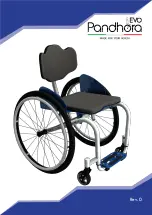
1-4
ZR Owner’s Manual
OM0005_Rev A_ZR
CHAPTER 1: WARNINGS
determine which methods are best suited to your abilities and those of the user.
2. ALWAYS communicate to the user what you plan to do before you do it and explain what you expect the user
to do while you are taking such action. This will put the user at ease and reduce the risk of an accident due to a
miscommunication.
3. ALWAYS use good posture and proper body mechanics in order to avoid injury to your back.
4. When you lift or support the user or tilt the chair, ALWAYS bend your knees slightly and keep your back as upright
and straight as you can.
5. Wheelchair push handles are designed to provide a secure location for an attendant to grip the rear of the
wheelchair to prevent a fall or tip-over. ALWAYS make sure the wheelchair has push handles and ALWAYS use
them. REGULARLY check to make sure the push handle grips are securely seated on the back canes so they will
not rotate or slip off.
6. If you are going to tilt the chair backward, ALWAYS remind the user to lean back.
7. If you are going to descend a curb or single step, ALWAYS lower the chair slowly in one easy movement. NEVER
let the chair drop the last few inches to the ground. This may damage the chair or injure the user.
8. ALWAYS become familiar with the user’s wheelchair and all of its parts and components. In particular, be very
aware of any removable parts. Removable parts must NEVER be used for a hand-hold or lifting supports because
they may inadvertently release, resulting in possible injury to the user and/or assistant.
9. Anti-tips may present a tripping hazard to the attendant. To avoid tripping over the anti-tips, unlock and rotate anti-
tip tubes up, out of the way. However, if you must leave the user unattended, even for a moment, ALWAYS rotate
the anti-tips back into the down position and lock the rear wheels using the wheel locks. This will reduce the risk
of a tip-over or loss of control of the chair.
10. When you are learning a new assistance technique, ALWAYS have an experienced attendant help you before
attempting it on your own.
If you ignore these Warnings, you may fall, tip over or lose control of the wheelchair and seriously injure yourself or
others or damage the wheelchair.
L. STANDING ON YOUR CHAIR
I
WARNING
Your TiLite wheelchair has been designed for use as a wheelchair, not as a step ladder. NEVER stand on your TiLite
wheelchair.
If you ignore these Warnings, you may fall, tip over or lose control of the wheelchair and seriously injure yourself or
others or damage the wheelchair.
WARNINGS FOR SAFE USE OF YOUR WHEELCHAIR
A. LEARNING TO DO A “WHEELIE”
I
WARNING
DO NOT attempt to perform a “wheelie” in your wheelchair because of the dangerous nature of this kind of maneuver.
TiLite recognizes that some wheelchair users will ignore this warning. If you should choose to ignore this warning,
you should follow these steps to help learn to do a “wheelie” as safely as possible (but doing a “wheelie” is never
completely safe and TiLite assumes no responsibility for any injury you may sustain as a result of doing a “wheelie”):
1. Read and follow the Warning for “WHEELIES” on page 1-11.
2. NEVER attempt to learn how to do a “wheelie” without the assistance of someone strong enough to catch you
should you start to tip over (a “spotter”). Your spotter should read and be completely familiar with this entire
Manual, especially this Warning and the Warning for “WHEELIES” on page 1-11.
3. Instruct your spotter to stand at the rear of your chair. Your spotter must be agile enough to move with you and
your chair to prevent a tip-over.
4. Instruct your spotter to keep his or her hands BENEATH the push handles or backrest rigidizer bar so that he or
she is ready to catch you if you exceed the balance point of the rear wheels and start to tip over backward.
5. When your spotter is in position and is ready, place your hands on the forward portion of the handrims. Using the
handrims, make a quick BACKWARD movement of the rear wheels, quickly followed by a hard FORWARD thrust.
This will tilt the chair up on the balance point of the rear wheels. DO NOT remove your hands from the handrims












































